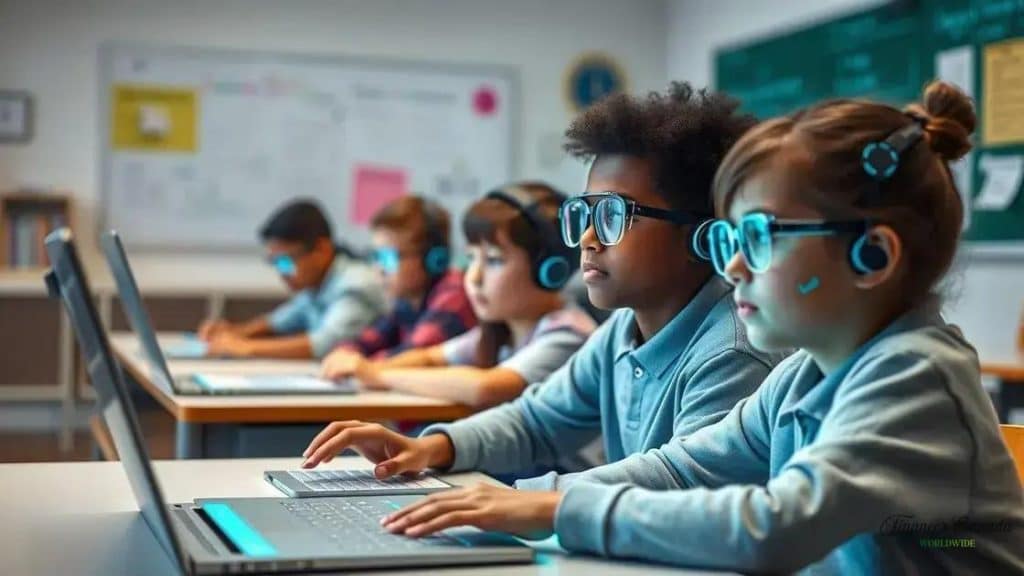The future of artificial intelligence in education

The future of artificial intelligence in education will enhance learning through personalized experiences, improve educational equity, and streamline classroom dynamics, while addressing challenges like data privacy and teacher training.
The future of artificial intelligence in education is not just around the corner; it’s already shaping how we learn. Imagine a classroom where lessons adapt to individual student needs, making education more engaging and effective. Curious how this transformation is happening? Let’s dive in!
Understanding the role of AI in education
Understanding the role of AI in education is crucial for grasping how technology is transforming learning environments. AI can analyze student performance, helping teachers tailor lessons to individual needs. This makes learning more effective and engaging for students.
Consider how AI can assist with data analysis, enabling educators to make informed decisions. By evaluating trends and patterns, AI offers insights that allow teachers to pinpoint areas where students struggle. This targeted approach is vital for ensuring that every student receives the support they need.
Benefits of AI in Education
There are many ways AI benefits both students and teachers. Some key advantages include:
- Personalized learning experiences
- Improved access to resources
- Enhanced grading efficiencies
- Real-time feedback for students
As classrooms begin to incorporate AI tools, educators can foster a more interactive and adaptive atmosphere for learning. For instance, intelligent tutoring systems can adjust content according to each student’s pace, promoting better understanding and retention.
The role of AI also extends to administrative tasks, which can free up valuable time for teachers to focus on instruction. Automating processes such as grading and attendance tracking simplifies administrative burdens.
Challenges in Implementing AI
Despite the benefits, there are challenges educators face when integrating AI into classrooms. These include:
- Data privacy concerns
- Costs associated with technology
- Need for teacher training
Addressing these challenges is essential to create a successful AI-enhanced educational environment. By fostering collaboration between educators, tech developers, and policymakers, schools can pave the way for a future where AI in education is effectively utilized.
Personalized learning through AI

Personalized learning through AI is revolutionizing how students engage with educational content. By utilizing advanced algorithms, AI can tailor lessons to fit individual needs, making learning more effective and enjoyable.
Imagine a classroom where every student receives a unique learning experience. AI technologies assess students’ strengths and weaknesses, adapting to their learning pace. This tailored approach helps students master concepts at their own speed, which fosters confidence and curiosity.
How AI Supports Personalized Learning
There are several ways AI enhances personalized learning:
- Adaptive learning platforms modify content based on performance.
- Intelligent tutoring systems provide customized support outside of normal classroom hours.
- Interactive tools engage students in a way that resonates with their interests.
- Data analysis helps teachers identify which areas need extra focus.
With these tools, educators can focus on facilitating learning rather than just delivering content. For example, a student struggling with math can receive additional resources tailored to their specific gaps in understanding, while others progress faster through topics they find easier.
AI also promotes a sense of agency among learners. Students have more control over their educational journey, choosing how they wish to engage with materials. This increases motivation and fosters a love for learning that can last a lifetime.
Potential Challenges in Implementation
While the benefits of personalized learning through AI are clear, challenges exist. Schools need resources to implement such advanced technologies, and teachers must be trained to effectively use these tools. Ensuring that all students have access to the necessary technology is also critical.
Despite these hurdles, the potential for AI to transform education makes it a worthwhile investment. By addressing these challenges, schools can unlock opportunities for students that were never possible before.
AI tools transforming classroom dynamics
AI tools transforming classroom dynamics are reshaping how students interact with each other and their educators. These innovative technologies enhance collaboration and engagement, leading to richer learning experiences.
In the traditional classroom, teacher-led instruction dominated. Now, AI facilitates more interactive and student-driven environments. For instance, collaborative platforms enable students to work together on projects, regardless of their physical location.
Examples of AI Tools in the Classroom
Several AI tools are currently making a difference in classrooms:
- Virtual reality (VR) environments that immerse students in different learning scenarios.
- Chatbots that provide instant answers to student questions, creating a more responsive learning atmosphere.
- Learning analytics that track student progress, helping teachers adjust strategies promptly.
- Content creation tools that allow students to express their understanding creatively.
By incorporating these tools, educators can create an atmosphere where students feel more empowered to participate. Enhanced communication through AI fosters a sense of community, as students collaborate in real time and share their diverse perspectives.
Moreover, AI-driven tools analyze classroom interactions to boost participation. By identifying trends in student engagement, educators can modify their teaching approaches to better meet student needs. For example, if a tool indicates that certain topics cause disengagement, teachers can adapt their lessons accordingly, making them more relevant and interesting.
Benefits of AI-Enhanced Dynamics
Utilizing AI in the classroom offers several advantages, such as:
- Encouraging active learning through hands-on experiences.
- Fostering collaboration and teamwork among students.
- Enhancing accessibility for students with diverse learning needs.
- Creating personalized learning journeys that cater to individual strengths.
As schools continue adopting AI tools, we will likely see a new generation of learners who are more engaged, collaborative, and ready to tackle the complexities of the future.
Challenges of implementing AI in schools

The challenges of implementing AI in schools are significant, yet understanding them is crucial for successful integration. While AI offers transformative potential, there are hurdles that educators must navigate.
One major challenge is ensuring adequate funding for AI technologies. Schools often operate within tight budgets, making it difficult to invest in new tools and training programs. Without proper funding, even the best AI solutions cannot be effectively implemented.
Data Privacy Concerns
Another issue that arises with AI is data privacy. Schools must handle sensitive student information carefully. Establishing secure systems to protect this data is essential to maintain trust among students and parents.
- Compliance with federal and state regulations is necessary.
- Transparent policies about data usage should be in place.
- Training staff on data protection methods is vital.
Moreover, AI tools require ongoing maintenance and updates. This can be a daunting task for schools lacking technical support teams. Having reliable IT staff is critical for ensuring that AI systems run smoothly and efficiently.
Teacher Training and Support
Equipping teachers with the necessary skills to utilize AI tools is another significant challenge. Professional development programs must offer training on how to effectively integrate these technologies into the classroom. Teachers need to feel comfortable using AI to maximize the benefits for their students.
Additionally, educators should have access to ongoing support as they adopt AI tools. This can help teachers share experiences and learn from each other, promoting a culture of collaboration and growth.
Finally, addressing the digital divide is essential. Not all students possess equal access to technology, which can hinder the effectiveness of AI tools. Bridging this gap is crucial to ensure that all students benefit from advancements in education.
The impact of AI on educational equity
The impact of AI on educational equity is profound, offering opportunities to level the playing field for all students. AI can address learning disparities by providing tailored resources that meet diverse needs.
One of the most significant ways AI promotes equity is through personalized learning experiences. By analyzing individual student data, AI platforms can adapt lessons to fit different learning styles and paces. This means that students who may struggle in traditional settings can receive targeted support, helping them succeed academically.
Bridging the Gap in Resources
AI tools can also bridge gaps in access to educational resources. In many areas, schools may not have the funding for the latest technology or experienced teachers for every subject. AI can supplement this by providing:
- Access to online tutoring services that are available 24/7.
- Interactive learning modules that engage students outside the classroom.
- High-quality materials that can be accessed by any student with an internet connection.
Furthermore, these tools can help teachers identify students who may need additional assistance, ensuring that no one falls behind. By making resources available to all students, AI helps create a more equitable educational environment.
Addressing Bias in Education
However, it’s essential to acknowledge potential challenges. AI systems can inadvertently perpetuate biases present in their training data. To combat this, developers must ensure that AI algorithms are fair and represent diverse perspectives.
Equity in education through AI also means being mindful of technology access disparities. Not every student has the same access to devices or the internet. Initiatives to provide devices and internet access to underserved communities are crucial for ensuring that AI benefits all learners.
Ultimately, the goal of using AI in education is to empower every student to reach their full potential. By addressing inequities and providing personalized paths to learning, AI can be a powerful tool for positive change in educational systems around the world.
FAQ – Frequently Asked Questions About AI in Education
How can AI enhance personalized learning?
AI analyzes individual student data to tailor lessons, helping each student learn at their own pace and improving their understanding.
What are the benefits of AI for educational equity?
AI provides access to resources for all students, helping to reduce disparities by offering personalized support and learning materials.
What challenges do schools face when implementing AI?
Schools may struggle with funding, data privacy concerns, and ensuring teachers receive proper training to use AI tools effectively.
How can educators ensure data privacy when using AI?
Educators should implement secure systems, comply with regulations, and maintain transparent policies on data usage to protect student information.





